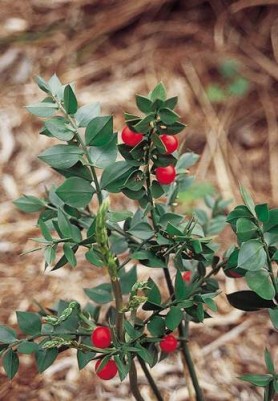
|
|
Butcher's-broom
(Ruscus aculeatus)
|
Butcher's
broom - Ruscus aculeatus
Butcher's broom, also known as box holly or knee
holly, is a
fairly common, short evergreen shrub (Ruscus aculeatus L.) of the family
Liliaceae, native throughout the Mediterranean region from the Azores to Iran.
It's a perennial shrub from 25 to 100 cm
tall, which can be seen in its male or female form
as two separated plants. Both of them have smooth , round, dark-green stems. We
can hardly see its leaves and what might be taken as leaves are, in fact, the
cladodes , some modified stems, ovate -lanceolate, ending with a sharp little
spine. Flowers are greenish and little conspicuous. Female flowers are provided
with six lobes, being the inner three smaller than the outer ones. Male flowers
have joined the three stamens. The most outstanding , appealing part of the
plant is the fruit ;a round red berry. When
completely grown , it looks like a little ball stuck in the middle of the "false
leaf". The fruits are ripe in September, and remain
attached to the plant all the winter and cause it often to be picked for room
decoration.
In the Middle Ages the young shoots of Butcher's Broom have often been eaten like
those of the Asparagus, a plant to which it is closely allied. The matured
branches used to be bound into bundles. It is frequently made into besoms in
Italy. Especially butchers were supposed to have used such brooms and brushes a
lot. Presumably to clean the floors and the chopping blocks, hence the herbís
English name; Butcherís Broom.
Butcher's Broom sometimes called Knee Holly, though it is in no way allied to the
true Holly, being a member of the Lily tribe.
The name Knee Holly appears to have been given it from its rising to about the
height of a man's knee (though occasionally specimens are found growing about 3
feet high), and from its having, like the true Holly, prickly leaves, which are
also evergreen.
Butcher's-broom, too, has a long history of use in herbal
medicine. As early as
the first century, Dioscorides recommended butcher's-broom as a laxative and
diuretic. The seventeenth-century apothecary-astrologer Nicholas Culpeper
suggested that a decoction of the root be drunk and a poultice of the berries
and leaves applied to facilitate the knitting of broken bones. However, the drug never became popular in either Europe or the United
States and was seldom mentioned in standard references on drugs. Butcher's broom is not used much
today, but, in view of its
positive effect on varicose
veins and hemorrhoids,
it could be due for a revival. In the European tradition, both the aerial parts
and the rhizome are considered to be diuretic and mildly laxative.
Source:
http://www.herbs2000.com/herbs/herbs_butchers_broom.htm
http://www.savant-hdc.com/ruscus.htm
http://www.botanical.com/botanical/mgmh/b/brobut71.html
